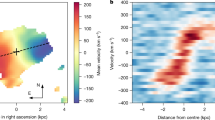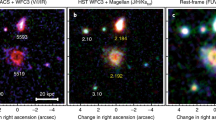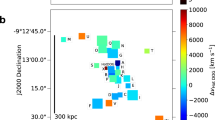Abstract
The extreme astrophysical processes and conditions that characterize the early Universe are expected to result in young galaxies that are dynamically different from those observed today1,2,3,4,5. This is because the strong effects associated with galaxy mergers and supernova explosions would lead to most young star-forming galaxies being dynamically hot, chaotic and strongly unstable1,2. Here we report the presence of a dynamically cold, but highly star-forming, rotating disk in a galaxy at redshift6 z = 4.2, when the Universe was just 1.4 billion years old. Galaxy SPT–S J041839–4751.9 is strongly gravitationally lensed by a foreground galaxy at z = 0.263, and it is a typical dusty starburst, with global star-forming7 and dust properties8 that are in agreement with current numerical simulations9 and observations10. Interferometric imaging at a spatial resolution of about 60 parsecs reveals a ratio of rotational to random motions of 9.7 ± 0.4, which is at least four times larger than that expected from any galaxy evolution model at this epoch1,2,3,4,5 but similar to the ratios of spiral galaxies in the local Universe11. We derive a rotation curve with the typical shape of nearby massive spiral galaxies, which demonstrates that at least some young galaxies are dynamically akin to those observed in the local Universe, and only weakly affected by extreme physical processes.
This is a preview of subscription content, access via your institution
Access options
Access Nature and 54 other Nature Portfolio journals
Get Nature+, our best-value online-access subscription
$29.99 / 30 days
cancel any time
Subscribe to this journal
Receive 51 print issues and online access
$199.00 per year
only $3.90 per issue
Buy this article
- Purchase on Springer Link
- Instant access to full article PDF
Prices may be subject to local taxes which are calculated during checkout




Similar content being viewed by others
Data availability
This study used the ALMA data 2016.1.01499.S, available at http://almascience.eso.org/aq/.
Code availability
The methodology used for the source reconstruction and its kinematic modelling is fully explained in ref. 13. The code is available from the corresponding author upon reasonable request.
Change history
22 August 2020
A Correction to this paper has been published: https://doi.org/10.1038/s41586-020-2693-y
References
Pillepich, A. et al. First results from the TNG50 simulation: the evolution of stellar and gaseous discs across cosmic time. Mon. Not. R. Astron. Soc. 490, 3196–3233 (2019).
Dekel, A. & Burkert, A. Wet disc contraction to galactic blue nuggets and quenching to red nuggets. Mon. Not. R. Astron. Soc. 438, 1870–1879 (2014).
Zolotov, A. et al. Compaction and quenching of high-z galaxies in cosmological simulations: blue and red nuggets. Mon. Not. R. Astron. Soc. 450, 2327–2353 (2015).
Krumholz, M. R., Burkhart, B., Forbes, J. C. & Crocker, R. M. A unified model for galactic discs: star formation, turbulence driving, and mass transport. Mon. Not. R. Astron. Soc. 477, 2716–2740 (2018).
Hayward, C. C. & Hopkins, P. F. How stellar feedback simultaneously regulates star formation and drives outflows. Mon. Not. R. Astron. Soc. 465, 1682–1698 (2017).
Weiß, A. et al. ALMA redshifts of millimeter-selected galaxies from the SPT survey: the redshift distribution of dusty star-forming galaxies. Astrophys. J. 767, 88 (2013).
De Breuck, C. et al. A dense, solar metallicity ISM in the z= 4.2 dusty star-forming galaxy SPT 0418–47. Astron. Astrophys. 631, A167 (2019).
Gullberg, B. et al. The nature of the [C ii] emission in dusty star-forming galaxies from the SPT survey. Mon. Not. R. Astron. Soc. 449, 2883–2900 (2015).
McAlpine, S. et al. The nature of sub-millimeter and highly star-forming galaxies in the EAGLE simulation. Mon. Not. R. Astron. Soc. 488, 2440–2454 (2019).
Hodge, J. A. et al. The kiloparsec-scale star formation law at redshift 4: widespread, highly efficient star formation in the dust-obscured starburst galaxy GN20. Astrophys. J. Lett. 798, 18 (2015).
Lelli, F., McGaugh, S. S. & Schombert, J. M. SPARC: mass models for 175 disk galaxies with spitzer photometry and accurate rotation curves. Astron. J. 152, 157 (2016).
Stacey, G. J. et al. A 158 μm [C ii] line survey of galaxies at z~ 1–2: an indicator of star formation in the early Universe. Astrophys. J. 724, 957–974 (2010).
Rizzo, F., Vegetti, S., Fraternali, F. & Di Teodoro, E. A novel 3D technique to study the kinematics of lensed galaxies. Mon. Not. R. Astron. Soc. 481, 5606–5629 (2018).
Toomre, A. On the gravitational stability of a disk of stars. Astrophys. J. 139, 1217–1238 (1964).
Carilli, C. L. & Walter, F. Cool gas in high-redshift galaxies. Annu. Rev. Astron. Astrophys. 51, 105–161 (2013).
Chen, C.-C. et al. An ALMA survey of submillimeter galaxies in the Extended Chandra Deep Field South: near-infrared morphologies and stellar sizes. Astrophys. J. 799, 194 (2015).
Lang, P. et al. Bulge growth and quenching since z = 2.5 in CANDELS/3D-HST. Astrophys. J. 788, 11 (2014).
Krajnović, D. et al. The ATLAS3D project – XVII. Linking photometric and kinematic signatures of stellar discs in early-type galaxies. Mon. Not. R. Astron. Soc. 432, 1768–1795 (2013).
Toft, S. et al. Submillimeter galaxies as progenitors of compact quiescent galaxies. Astrophys. J. 782, 68 (2014).
Barro, G. et al. CANDELS+3D-HST: compact SFGs at z ~ 2–3, the progenitors of the first quiescent galaxies. Astrophys. J. 791, 52 (2014).
Cappellari, M. et al. The ATLAS3D project – I. A volume-limited sample of 260 nearby early-type galaxies: science goals and selection criteria. Mon. Not. R. Astron. Soc. 413, 813–836 (2011).
McDermid, R. M. et al. The ATLAS3D Project – XXX. Star formation histories and stellar population scaling relations of early-type galaxies. Mon. Not. R. Astron. Soc. 448, 3484–3513 (2015).
Naab, T., Johansson, P. H. & Ostriker, J. P. Minor mergers and the size evolution of elliptical galaxies. Astrophys. J. Lett. 699, 178–182 (2009).
Cappellari, M. et al. The ATLAS3D project – XX. Mass-size and mass-σ distributions of early-type galaxies: bulge fraction drives kinematics, mass-to-light ratio, molecular gas fraction and stellar initial mass function. Mon. Not. R. Astron. Soc. 432, 1862–1893 (2013).
Di Teodoro, E. M., Fraternali, F. & Miller, S. H. Flat rotation curves and low velocity dispersions in KMOS star-forming galaxies at z ~ 1. Astron. Astrophys. 594, A77 (2016).
Wisnioski, E. et al. The KMOS3D survey: design, first results, and the evolution of galaxy kinematics from 0.7 ≤ z ≤ 2.7. Astrophys. J. 799, 209 (2015).
Lelli, F. et al. Neutral versus ionized gas kinematics at z≃2.6: the AGN-host starburst galaxy PKS 0529–549. Mon. Not. R. Astron. Soc. 479, 5440–5447 (2018).
Turner, O. J. et al. The KMOS Deep Survey (KDS) - I. Dynamical measurements of typical star-forming galaxies at z ≃ 3.5. Mon. Not. R. Astron. Soc. 471, 1280–1320 (2017).
Harrison, C. M. et al. The KMOS Redshift One Spectroscopic Survey (KROSS): rotational velocities and angular momentum of z ≈ 0.9 galaxies. Mon. Not. R. Astron. Soc. 467, 1965–1983 (2017).
Swinbank, A. M. et al. Angular momentum evolution of galaxies over the past 10 Gyr: a MUSE and KMOS dynamical survey of 400 star-forming galaxies from z = 0.3 to 1.7. Mon. Not. R. Astron. Soc. 467, 3140–3159 (2017).
Carlstrom, J. E. et al. The 10 meter South Pole Telescope. Publ. Astron. Soc. Pacif. 123, 568–581 (2011).
Vieira, J. D. et al. Dusty starburst galaxies in the early Universe as revealed by gravitational lensing. Nature 495, 344–347 (2013).
McMullin, J. P., Waters, B., Schiebel, D., Young, W. & Golap, K. CASA architecture and applications. ASP Conf. Ser. 376, 127–130 (2007).
Högbom, J. A. Aperture synthesis with a non-regular distribution of interferometer baselines. Astron. Astrophys. Suppl. Ser. 15, 417–426 (1974).
Powell, D., Vegetti, S., McKean, J. P. & Spingola, C. A novel approach to visibility-space modelling of interferometric gravitational lens observations at high angular resolution. Preprint at https://arxiv.org/abs/2005.03609 (2020).
Vegetti, S. & Koopmans, L. V. E. Bayesian strong gravitational-lens modelling on adaptive grids: objective detection of mass substructure in Galaxies. Mon. Not. R. Astron. Soc. 392, 945–963 (2009).
Greengard, L. & Lee, J.-Y. Accelerating the nonuniform fast Fourier transform. SIAM Rev. 46, 443–454 (2004).
Beatty, P. J., Nishimura, D. G. & Pauly, J. M. Rapid gridding reconstruction with a minimal oversampling ratio. IEEE Trans. Med. Imaging 24, 799–808 (2005).
Koopmans, L. V. E., Treu, T., Bolton, A. S., Burles, S. & Moustakas, L. A. The Sloan Lens ACS Survey. III. The structure and formation of early-type galaxies and their evolution since z~1. Astrophys. J. 649, 599–615 (2006).
Barnabè, M. et al. Two-dimensional kinematics of SLACS lenses – II. Combined lensing and dynamics analysis of early-type galaxies at z=0.08–0.33. Mon. Not. R. Astron. Soc. 399, 21–36 (2009).
Spilker, J. S. et al. ALMA imaging and gravitational lens models of south pole telescope—selected dusty, star-forming galaxies at high redshifts. Astrophys. J. 826, 112 (2016).
Feroz, F., Hobson, M. P., Cameron, E. & Pettitt, A. N. Importance nested sampling and the MultiNest algorithm. Open J. Astr. 2, 10 (2019).
Di Teodoro, E. M. & Fraternali, F. 3DBAROLO: a new 3D algorithm to derive rotation curves of galaxies. Mon. Not. R. Astron. Soc. 451, 3021–3033 (2015).
Jones, G. C. et al. Dynamical characterization of galaxies at z~ 4–6 via tilted ring fitting to ALMA [C ii] observations. Astrophys. J. 850, 180 (2017).
Smit, R. et al. Rotation in [C ii]-emitting gas in two galaxies at a redshift of 6.8. Nature 553, 178–181 (2018).
Übler, H. et al. Ionized and molecular gas kinematics in a z=1.4 star-forming galaxy. Astrophys. J. 854, L24 (2018).
Girard, M. et al. Towards sub-kpc scale kinematics of molecular and ionized gas of star-forming galaxies at z~1. Astron. Astrophys. 631, A91 (2019).
Übler, H. et al. The evolution and origin of ionized gas velocity dispersion from z~2.6 to z~0.6 with KMOS3D. Astrophys. J. 880, 48 (2019).
Hung, C.-L. et al. What drives the evolution of gas kinematics in star-forming galaxies? Mon. Not. R. Astron. Soc. 482, 5125–5137 (2019).
Teklu, A. F. et al. Declining rotation curves at z=2 in ΛCDM galaxy formation simulations. Astrophys. J. 854, L28 (2018).
Bird, J. C. et al. Inside out and upside down: tracing the assembly of a simulated disk galaxy using mono-age stellar populations. Astrophys. J. 773, 43 (2013).
Martizzi, D. Global simulations of galactic discs: violent feedback from clustered supernovae during bursts of star formation. Mon. Not. R. Astron. Soc. 492, 79–95 (2020).
Iorio, G. et al. LITTLE THINGS in 3D: robust determination of the circular velocity of dwarf irregular galaxies. Mon. Not. R. Astron. Soc. 466, 4159–4192 (2017).
Lima Neto, G. B., Gerbal, D. & Márquez, I. The specific entropy of elliptical galaxies: an explanation for profile-shape distance indicators? Mon. Not. R. Astron. Soc. 309, 481–495 (1999).
Terzić, B. & Graham, A. W. Density-potential pairs for spherical stellar systems with Sérsic light profiles and (optional) power-law cores. Mon. Not. R. Astron. Soc. 362, 197–212 (2005).
Zanella, A. et al. The [C ii] emission as a molecular gas mass tracer in galaxies at low and high redshifts. Mon. Not. R. Astron. Soc. 481, 1976–1999 (2018).
Gullberg, B. et al. The dust and [C ii] morphologies of redshift ~4.5 sub-millimeter galaxies at ~200 pc resolution: the absence of large clumps in the interstellar medium at high-redshift. Astrophys. J. 859, 12 (2018).
Navarro, J. F., Frenk, C. S. & White, S. D. M. The structure of cold dark matter halos. Astrophys. J. 462, 563 (1996).
Dutton, A. A. & Macciò, A. V. Cold dark matter haloes in the Planck era: evolution of structural parameters for Einasto and NFW profiles. Mon. Not. R. Astron. Soc. 441, 3359–3374 (2014).
Speagle, J. S. dynesty: a dynamic nested sampling package for estimating Bayesian posteriors and evidences. Preprint at https://arxiv.org/abs/1904.02180 (2019).
Cappellari, M. et al. The ATLAS3D project – XV. Benchmark for early-type galaxies scaling relations from 260 dynamical models: mass-to-light ratio, dark matter, Fundamental Plane and Mass Plane. Mon. Not. R. Astron. Soc. 432, 1709–1741 (2013).
Emsellem, E. et al. The ATLAS3D project – III. A census of the stellar angular momentum within the effective radius of early-type galaxies: unveiling the distribution of fast and slow rotators. Mon. Not. R. Astron. Soc. 414, 888–912 (2011).
Aravena, M. et al. A survey of the cold molecular gas in gravitationally lensed star-forming galaxies at z>2. Mon. Not. R. Astron. Soc. 457, 4406–4420 (2016).
Kennicutt, R. C. & Evans, N. J. Star formation in the Milky Way and nearby galaxies. Annu. Rev. Astron. Astrophys. 50, 531–608 (2012).
Tamburro, D. et al. What is driving the H i velocity dispersion? Astrophys. J. 137, 4424–4435 (2009).
Utomo, D., Blitz, L. & Falgarone, E. The origin of interstellar turbulence in M33. Astrophys. J. 871, 17 (2019).
Rafelski, M. et al. The star formation rate efficiency of neutral atomic-dominated hydrogen gas in the outskirts of star-forming galaxies from z~1 to z~3. Astrophys. J. 825, 87 (2016).
Leroy, A. K. et al. The multi-phase cold fountain in M82 revealed by a wide, sensitive map of the molecular interstellar medium. Astrophys. J. 814, 83 (2015).
Lelli, F., Verheijen, M. & Fraternali, F. Dynamics of starbursting dwarf galaxies. III. A H I study of 18 nearby objects. Astron. Astrophys. 566, A71 (2014).
Planck Collaboration. Planck 2015 results XIII. Cosmological parameters. Astron. Astrophys. 594, A13 (2016).
Acknowledgements
This study used ALMA data 2016.1.01499.S. ALMA is a partnership of ESO (representing its member states), NSF (USA) and NINS (Japan) with NRC (Canada), NSC and ASIAA (Taiwan) and KASI (Republic of Korea), in cooperation with the Republic of Chile. The Joint ALMA Observatory is operated by ESO, AUI/NRAO and NAOJ. S.V. received funding from the European Research Council (ERC) under the European Union’s Horizon 2020 research and innovation programme (grant agreement number 758853). F.R. thanks T. Naab and T. Costa for useful comments and discussions.
Author information
Authors and Affiliations
Contributions
F.R., F.F. and S.V. analysed the data. D.P., F.R. and S.V. developed the software used for the lens–kinematic modelling. F.R. developed the software for the dynamical analysis. H.R.S. and F.R. reduced the data. F.R., J.P.M., S.V. and H.R.S. contributed to the writing of the manuscript. F.F. and S.D.M.W. helped with the interpretation of the scientific results. All authors discussed the results and provided comments on the paper.
Corresponding author
Ethics declarations
Competing interests
The authors declare no competing interests.
Additional information
Publisher’s note Springer Nature remains neutral with regard to jurisdictional claims in published maps and institutional affiliations.
Extended data figures and tables
Extended Data Fig. 1 Reconstruction of the [C ii] emission and kinematic model.
The rows show representative channel maps at the velocity shown on the upper left corner of column 4. Columns 1 and 2 show the ‘dirty’ image of the data and the model, respectively, colour-coded by the flux in units of mJy per beam. Column 3 shows the residuals (data minus model) normalized to the noise. Columns 5 and 6 show the contours of the reconstructed source and of the kinematic model used to constrain the source reconstruction. The contour levels in the last columns are set at n = 0.1, 0.2, 0.4, 0.6, 0.8 times the value of the maximum flux of the kinematic model.
Extended Data Fig. 2 Corner plot showing the posterior distributions of the lens and kinematic parameters.
The dark and light areas in the two-dimensional distributions show the 39% and 86% confidence levels, corresponding to 1 s.d. and 2 s.d., respectively, obtained with the fiducial methodology described in Rizzo et al.13 (green) and with the direct forward modelling method (grey). From left to right, the first six panels show the lens parameters, and the other panels show the source kinematic parameters (see also Extended Data Table 1).
Extended Data Fig. 3 Corner plot showing the posterior distributions of the dynamical parameters.
The posterior distributions are the results of the decomposition of the circular velocity (Fig. 2c) into the physical components contributing to the total gravitational potential: the stars, the gas disks and the dark-matter halo. The fitted parameters are the stellar mass Mstar, the effective radius, Re, the Sérsic index, n (Sérsic profile), the mass of an NFW dark-matter halo, MDM and the conversion factor between the [C ii] luminosity and the gas mass, α[Cii]. The dashed lines in the one-dimensional histograms show the 16th, 50th and 84th percentiles (see Extended Data Table 5).
Rights and permissions
About this article
Cite this article
Rizzo, F., Vegetti, S., Powell, D. et al. A dynamically cold disk galaxy in the early Universe. Nature 584, 201–204 (2020). https://doi.org/10.1038/s41586-020-2572-6
Received:
Accepted:
Published:
Issue Date:
DOI: https://doi.org/10.1038/s41586-020-2572-6
This article is cited by
-
Evolutionary stages in a noninteger dimensional universe
Indian Journal of Physics (2023)
-
Cosmic ray feedback in galaxies and galaxy clusters
The Astronomy and Astrophysics Review (2023)
-
Information-theoretic view of the gravitational constant in Dirac’s large numbers hypothesis
Indian Journal of Physics (2023)
-
Spatial variations in aromatic hydrocarbon emission in a dust-rich galaxy
Nature (2023)
-
A Milky Way-like barred spiral galaxy at a redshift of 3
Nature (2023)
Comments
By submitting a comment you agree to abide by our Terms and Community Guidelines. If you find something abusive or that does not comply with our terms or guidelines please flag it as inappropriate.



